Festo DGC-K-18 Handleiding
Festo
Niet gecategoriseerd
DGC-K-18
Bekijk gratis de handleiding van Festo DGC-K-18 (4 pagina’s), behorend tot de categorie Niet gecategoriseerd. Deze gids werd als nuttig beoordeeld door 4 mensen en kreeg gemiddeld 3.7 sterren uit 2.5 reviews. Heb je een vraag over Festo DGC-K-18 of wil je andere gebruikers van dit product iets vragen? Stel een vraag
Pagina 1/4

DGC-K-18 … -80
Postfach
73726 Esslingen
Germany
+49 711 347-0
www.festo.com
Operating instructions 8025694
1306a
[8025692]
Original: de
Linear actuator DGC-K-18 … -80 English. . . . . . . . . . . . . . . . . . . . . . . . . . . . . . . . . .
Note
Installation and commissioning are to be carried out only by qualified specialists
(operating instructions).
1 Control sections and connections
1 2 3 4
6
2 5
89 7
1Connection cap
2Regulating screw for internal
end-position cushioning
3Slide
4Mounting thread for useful load
5End cap
6Slot for proximity sensor
1)
7Mounting slots in the profile
8Pneumatic connections
9Thread for direct mounting on the
cover
2)
1) Accessories
2) In the DGC-K-18 ...-63, the threads are in the cover screws.
The DGC-K-80 has separate threads.
Fig. 1
2 Function and application
When the pneumatic ports 7are pressurized altern-
atingly, the piston moves backwards and forwards in
the profile barrel. By means of a rigid connection, the
slide 3also moves. The slot in the profile barrel re-
quired for this is covered by a band system.
Fig. 2 Circuit symbol
The DGC-K is intended for the space-saving transport
of loads.
It is approved for the slide operating mode.
Fig. 3 Slide mode
Note
Unpressurized movement of the slide is permitted only for fault correction and at
low speed. If excessive speed is used, the resulting low pressure can pull the
sealing band into the piston chamber. This leads to:
– high leakage and
– impermissible acceleration (e.g. when installed vertically).
3 Transport and storage
• Consider the weight of the DGC-K.
The DGC-K weighs up to 82 kg, depending on the design.
For transport, the conveyors must be spaced according to the permissible sup-
port spacings (support spacings Fig. 4 and Fig. 5).
4 Requirements for product use
Note
Improper handling can result in malfunctions.
• Make sure that the specifications contained in this chapter are adhered to at
all times.
This is the only way to ensure correct and safe product behaviour.
• Take into consideration the legal regulations applicable for the destination as
well as:
– regulations and standards
– regulations of the testing organizations and insurers
– national specifications.
• Remove all transport packaging such as plastic sheets, caps and cartons (ex-
cept for any covers in the pneumatic ports).
The material used in the packaging has been specifically chosen for its recyclab-
ility (exception: oil paper = residual waste).
• Use the product in its original status, without any unauthorised product modific-
ations.
• Take into consideration the ambient conditions at the location of use.
Corrosive environments (e.g. ozone) will reduce the service life of the product.
• Compare the limit values specified in these operating instructions with your
actual application (e.g. pressures, forces, torques, temperatures, loads,
speeds).
Operation of the product in compliance with the relevant safety regulations is
contingent on adherence to the load limits.
• Take the tolerance of the tightening torques into account.
Unless otherwise specified, the tolerance is ±20 %.
For vertical installation:
• Make sure that the slide has reached a stable position when it comes to a stop
(e.g. the lowest point or secured with external stops).
• Make sure the compressed air is properly prepared (Technical data).
• Maintain the selected medium for the total service life of the product. Example:
Always use non-lubricated compressed air.
• Slowly pressurise the system as a whole.
There will then be no uncontrolled movements.
For slow start-up pressurisation, use start-up valve type HEL.
5 Installation
5.1 Installation, mechanical
• Avoid the sealing band being pressed and/or sucked in.
Damage to the sealing band reduces its reliability in operation. Jerky movement
of the unpressurized slide can cause a partial vacuum that sucks the sealing
band into the piston chamber.
• Avoid the band system becoming damaged or excessively dirty.
Damage to the DGC-K will reduce its reliability and service life.
• Make sure that the device is installed free of distortion and deflection.
• Use:
– the mounting thread 9for direct mounting to the connection and end
cap 1and 5
– The mounting slots with large stroke lengths for attachment via the profile,
taking into account the recommended support spacings (Fig. 4 and Fig. 5).
• Select the corresponding mounting accessories from our catalogue
(www.festo.com/catalogue).
Note
• Make sure that the travel range of the drive is not restricted by the attach-
ments to the profile (in particular with lateral attachment).
• To do this, push the movable load one time over the complete positioning
path.
)HVWR6(& Co. KG

DGC-K-18
DGC-K-25
DGC-K-32
DGC-K-40
DGC-K-50
DGC-K-63
DGC-K-80
Fig. 4 Required support spacing (l) with horizontal mounting orientation
DGC-K-18
DGC-K-25
DGC-K-32
DGC-K-40
DGC-K-50
DGC-K-63
DGC-K-80
Fig. 5 Required support spacing (l) with horizontal mounting orientation
• Note the tightening torques when attaching.
Tightening torques of the mounting screws
Direct mounting on thread 9
Size 18 25 40 50 63 8032
[Nm] 2.5 143 4 5 8 45
Slot attachments (e.g. with MUP central support)
Size 18 25 40 50 63 8032
[Nm] 3 3 4.5 5.5 18 18 18
Fig. 6
Note
With hard and stiff useful loads:
If the slide 3is bent due to a buckled use-
ful load, it will reduce the service life of the
drive.
• Make sure the mounting surface of the
useful load is even.
Fig. 7
• Observe the tightening torques for the threads 4in the slide.
Size
18 25 40 50 63 8032
Thread M5 M6 M8 M12
Tightening torques [Nm] 3.5 12 306
Fig. 8
Effective loads with own guide:
• Adjust the guides of the effective load and of the DGC-K so that they are exactly
parallel.
In this way can you avoid overloading on the slide (Permissible forces
11 Technical data).
The driver DARD-L1 offers a torque-free and almost backlash-free power trans-
mission (www.festo.com/catalogue).
5.2 Installation, pneumatic
For installation in a vertical or inclined position:
Warning
If there is a pressure drop, the movable load will drop down:
Danger of crushing!
• Check whether HGL non-return valves are necessary.
In this way, you can prevent the movable load from sliding down suddenly.
• Check whether safety measures are required to prevent sinking as a result of
leakage (e.g. toothed latches or moveable bolts).
A(2)
A(1)
A(2)
W(2)
1
2
A(1)
W(1)
1 2
W = compressed air supply ports from
the plant
1= end position on the connection
side
1 = movement to the connection side
A = alternative connections
2= end position connection side
2 = movement to the connection side
Fig. 9
• Select the suitable compressed air supply ports.
In addition to the supply ports provided at the factory (W), there are also the
alternative ports (A). These are fitted with plug screws.
For the linear actuator DGC-K of variant D2, the compressed air supply can be
made on both sides.
A(1)
W(1)
A(2)
A(2)
W(2)
1
2
A(1)
1
2
W = compressed air supply ports from
the plant
1= end position on the connection
side (left)
1 = movement to the connection
side (left)
A = alternative connections
2= end position connection
side (right)
2 = movement to the connection
side (right)
Fig. 10
For setting the speed:
• Rotate the one-way flow control valves GRLA into the supply ports.

5.3 Installation, electric
Position scanning with proximity sensors SME/SMT:
• Use grooves (S) for mounting the proximity sensors (Fig. 12).
• Observe the minimum distances between ferritic loads and the proximity
sensors.
In this way you will avoid incorrect switching as a result of external influences.
Minimum clearances [mm]
POS 18 25 40 50 63 8032
L1 10 0 0 0 0 0 0
21
3
DGC-K-18/-25
4 5
DGC-K-32 ... -80
21
20 0 0 0 0 0 0
30 0 – – – – –
4– – 10 30 10 20 10
5– – 10 30 10 20 10
L2 110 0 0 0 0 0 0
210 0 0 0 0 0 0
330 10 – – – – –
4– – 0 0 0 0 0
5– – 0 0 0 0 0
L3 130 10 10 30 10 20 10
20 0 0 0 0 0 0
310 0 – – – – –
4– – 0 0 0 0 0
5– – 0 0 0 0 0
L4 10 0 0 0 0 0 0
230 10 10 30 10 20 10
310 0 – – – – –
4– – 0 0 0 0 0
5– – 0 0 0 0 0
Fig. 11 (POS = position of proximity switch)
Laying the cables for the proximity switches:
• Observe that the cables for the proximity switches can be guided through the
groove.
5.4 Installation of accessories
• Use the following grooves for attachment of the accessories (Fig. 12).
S = Slot for proximity sensor
N = Slot for mounting accessories
DGC-K-18/-25 DGC-K-32 ... -80
S/N S/N
S/N
S
S
NN
N
N
S
S
N
N
Fig. 12
• Use the slot covers (www.festo.com/catalogue):
– to prevent contamination in the slots (S)
– for locking the cables of proximity switches.
6 Commissioning
6.1 Commissioning the complete system
• Slowly pressurise the system as a whole.
In this way you will prevent sudden uncontrolled movements.
For slow start-up pressurisation, use start-up valve type HEL.
6.2 Preparing for commissioning
Before each commissioning and in operation:
Warning
Fast moving parts can cause injury to people in the
environment of the DGC-K.
• Make sure that, in the travel range
– Nobody can reach into the path of the movable
components (e.g. by providing a protective
guard)
– There are no foreign objects in the path of the
moving components.
It should not be possible to touch the DGC-K until
the load has come to complete rest.
Fig. 13
Warning
Without external cushioning devices the DGC-K may be damaged if the maximum
values specified in the catalogue are exceeded.
• Make sure that the limit values are not exceeded even in the event of malfunc-
tions.
At medium or large useful loads or high speeds:
• Use the configuration tool “DGC-QuickCalc” for pneumatic drives in the support
portal (www.festo.com/sp).
• Make sure that cushioning devices are of sufficient size.
Without external cushioning devices the DGC-K will withstand maximum speeds
and useful loads as per catalogue specifications or table (Fig. 18).
6.3 Carrying out commissioning
Warning
Risk of collision!
• Note that, for the load geometries with projection,
the regulating screws 2of the DGC-K may only be
turned when the slide is at rest.
Fig. 14
1. Close the one-way flow control valves
– for both sides at first completely
– then one rotation open again.
Fig. 15
Using the internal end position cushioning PPV:
2. Close the adjusting screws for the internal end pos-
ition cushioning PPV 2
– on both sides at first completely
– then one rotation open again.
Fig. 16
Note
To set the end position cushioning:
• Make sure that the slide reaches the end positions without striking hard
against them or bouncing back.
3. Pressurize the DGC-K slowly as follows:
– at first on both sides simultaneously. The slide will then move slightly to a
centre of equilibrium.
– Then exhaust the DGC-K on one side.
In this way you can avoid peak loadings on the DGC-K and in the compressed
air network.
4. Start a test run.
5. Check whether the speed must be modified (5.2 Installation, pneumatic).
Product specificaties
| Merk: | Festo |
| Categorie: | Niet gecategoriseerd |
| Model: | DGC-K-18 |
Heb je hulp nodig?
Als je hulp nodig hebt met Festo DGC-K-18 stel dan hieronder een vraag en andere gebruikers zullen je antwoorden
Handleiding Niet gecategoriseerd Festo

2 Augustus 2025
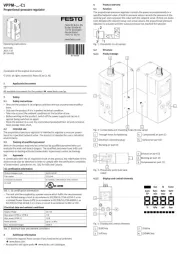
2 Augustus 2025
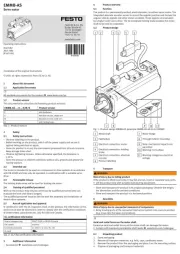
1 Augustus 2025
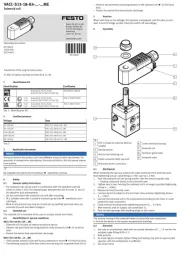
1 Augustus 2025
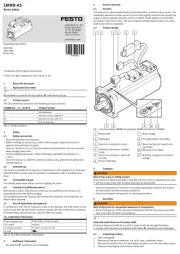
1 Augustus 2025
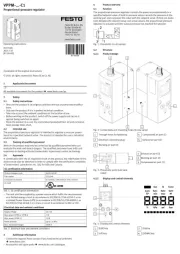
1 Augustus 2025
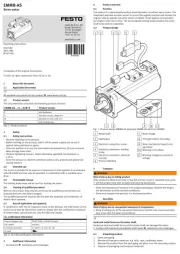
1 Augustus 2025
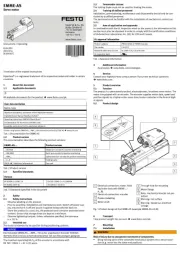
1 Augustus 2025
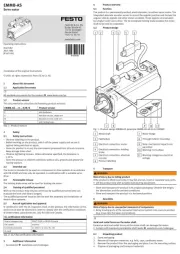
1 Augustus 2025
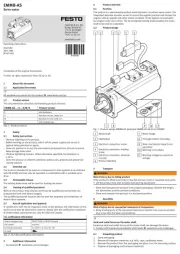
1 Augustus 2025
Handleiding Niet gecategoriseerd
- Qplay
- Nacon
- Eureka
- Armcross
- Vulcan
- EtherWAN
- Maclaren
- Esoteric
- Q-CONNECT
- Ezviz
- Dasqua
- RIDGID
- GlobalTronics
- EcoFlow
- Curtis
Nieuwste handleidingen voor Niet gecategoriseerd
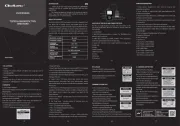
13 September 2025
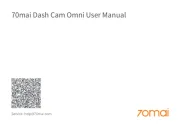
13 September 2025

13 September 2025

13 September 2025

13 September 2025
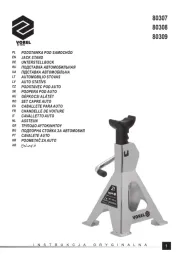
13 September 2025
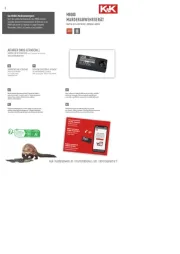
13 September 2025

13 September 2025

13 September 2025
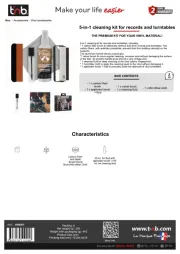
13 September 2025